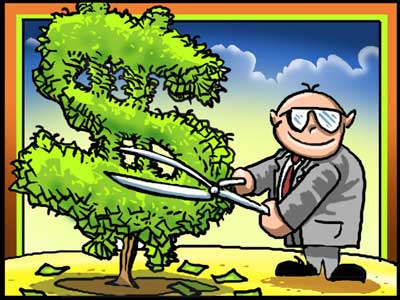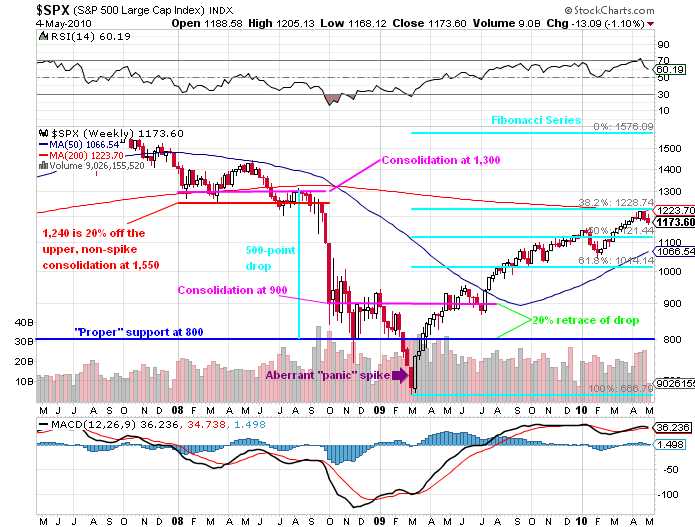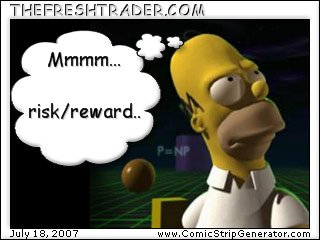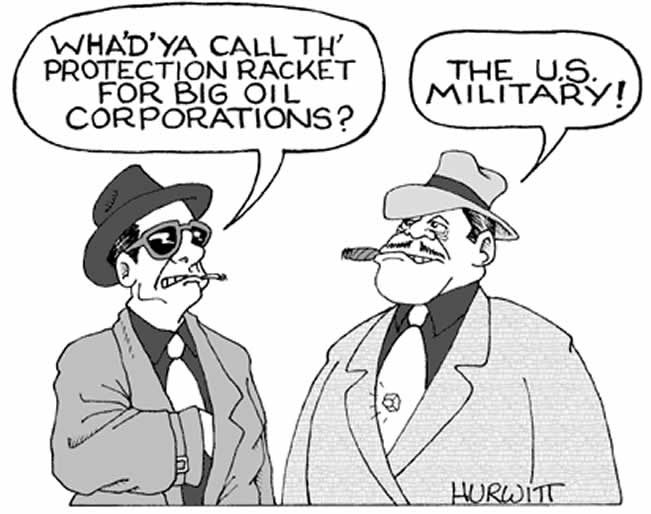 Be prepared isn’t just for boy scouts.
Be prepared isn’t just for boy scouts.
As I mentioned in yesterday’s post, we are in technical hell and the lack of recovery yesterday has left us on less than firm ground. As we still have clearly defined watch levels that aren’t too far away, now is a good time to look for some downside hedges that can help us enjoy the ride down while it lasts.
I was going to be pleased but then we had a very sharp, last minute sell-off on heavy volume that pretty much ruined the day. I have been bullish and we have been buying at what we thought was a bottom, and we are up to 35% invested in long-term, hedged positions but what if the 20% built-in protection (see "How to Buy a Stock for a 15-20% Discount") isn’t going to be enough?
You know I am a big fan of taking cash off the table in either direction, and we were not greedy and took off our short-term bearish directional bets on yesterday’s morning spike down. We had a couple of new hedges already in this week’s Member Chat but let’s look at some other trade ideas that can bullet-proof our virtual portfolios, all the way back to the March, 2009 lows. Our usual Mattress Strategy is not going to be enough to save us if we have another "flash crash" – especially one that sticks! Adding a layer of protection here doubles our returns if this is the first leg of a major sell-off, or it gives us a smaller hedge that we can roll up later while we take our earlier hedges off the table. As I have to say WAY too often to members – It’s not a profit until you cash it in!
Hedging for disaster is a concept I advocated during another "recovery," in October of 2008, where we made our cover plays to carry us through a worrisome holiday season and into Q1 earnings – "just in case." That "just in case" saved a lot of virtual portfolios! The idea of disaster hedges high return ETFs that will give you 3-5x returns in a major downturn. That way, 5% allocated of your virtual portfolio to protection can turn into 15-25% on a dip, giving you some much-needed cash right when there is a good buying opportunity. At the time, I advocated SKF Jan $100s at $19. SKF hit $300 around Thanksgiving and those calls made a profit of over $280 (1,400%), so putting even just 5% of your virtual portfolio into that financial hedge would give you back 75% of your virtual portfolio when you cash out.
Keep in mind these are INSURANCE plays – you expect to LOSE, not win but, if you need to ride out a lot of bullish positions through an uncertain period, this is a pretty good way to go. I still feel we are pretty much in the panic stage of the market cycle but I have to guard against the fact that I may be in denial, as well – which is pretty much what the cadre of bears have been advocating. Keep in mind the top of that range (euphoria) came at 11,200 and the bottom of our range (capitulation) came at 9,600 and that’s the range we’ve been in since last August. .

Looking at the above chart, we are HOPEFULLY at the Panic/Capitulation area. That is how we’ve been playing the game, as the "flash crash" came right after our cash out on April 28th and we jumped back in with a new Buy List on June 26th with an additional set of bullish Dow plays added on July 7th. At that time, I felt that we were clearly in Capiulation (and you may be interested to check the archives for what we said at the time about each day) and ready to rise. I saw the Flash crash (and the current move down if we keep going) as nothing more than the Fibonacci retrace of the S&P to 1,014 that we predicted on May 5th if the S&P was to fail at the 1,070 line. Here’s the chart from May 5th:

Tte nice thing about TA is that there are so many sheeple that follow it that we get to design our trades to take all their money as they stampede one way or the other. People who think TA doesn’t control the markets in the short-term are delusional. Do you think they are programing fundamentals into HFT algorithms? Of course not, it’s ALL TA, 90% of the trading in the markets these days is computers selling to other computers that were programmed by guys who only hold stock because it was part of the company’s compensation package. Sadly, this kind of thinking is prevelant now that most investors confuse a stock’s price with a stock’s value – but that’s an article for another day…
Let’s not kid ourselves, failing 1,014 would SUCK! I said on April 15th that we had to make a significant breakout on the Nasdaq or we would be in "technical Hell" and we made a nice stab of it but it was too weak with too little volume and that’s why we cashed out on April 28th – for technical, and not fundamental reasons. Perhaps that’s why I feel more bullish than most people – I had been bearish longer than most people and I’m ready to move on… In case my continued faith in the health of the US economy is really just denial, these hedges will help us transition to the next stage, where we can confidently commit more capital, knowing that we have a backstop in case things go wrong. Cash is still king and we are already committed to moving up to as much as 55% invested if the market drops 20% so it makes a lot of sense to put 5% into insurance that will mitigate a good portion of any drop.
 Don’t take these plays out of context – they are there to protect our plannd bottom fishing as well as our long-term bullish positions and we hope they all expire worthless! I would urge you to read the original Disaster Hedge post to get an idea of our mindset at the time, where I said:
Don’t take these plays out of context – they are there to protect our plannd bottom fishing as well as our long-term bullish positions and we hope they all expire worthless! I would urge you to read the original Disaster Hedge post to get an idea of our mindset at the time, where I said:
As far as hedging goes, if you are 50% invested and 50% in cash and you are worried about losing 20% on the stock side in a major sell-off, then the logic of these hedges is to take 40% of your cash (20% of your total) and put it on something that may double while the other positions lose. If things go down, your gains on the hedge offset some of the losses on your longer positions. If things go up, you can stop out with a 25% loss, which will "only" be a 5% hit on your total virtual portfolio but it means we are breaking through resistance and your upside bets are safe and doing well. That is not a bad trade-off for insurance in this crazy market. Also, be aware that these are thinly traded contracts with wide bid/ask spreads and you need to use caution establishing and exiting positions.
As we did in July we are very keyed on watching our February levels for support, which were at the time: Dow at 9,835, S&P 1,044, Nasdaq at 2,100, NYSE 6,631 and Russell 580. The Russell has been leading us lower and we’ll be looking for them to hold that line, but we’ve come close to a test yesterday on all but the Dow. If we are heading further down, the 1,010 line on the S&P from July is life and death and we are already testing below 1,044 this week in the S&P futures.
We had a very happy Thanksgiving in 2008 BECAUSE we were prepared for a nice correction and I want people to be able to enjoy 2010 the same way so that is the goal of our new protectors. Here’s a few ideas to help ride out a larger downturn as well as to protect our eventual buys:
- DXD Jan $27 calls at $4.30, selling Jan $32 calls for $2.70 and selling Oct $27 puts for $1.20. This is a net .40 entry on a $6 spread so your upside is 1,400% at $32 (DXD is now $28.66 so you are 315% in the money to start!). I like this /play because you are starting out $1.66 in the money on your spread. If the Dow ends up holding 10,000 and moves back up, there’s a good chance you can kill this cover with a small loss as a $1.66 move on DXD is 5% and that would be about a 2.5% move up in the Dow to 10,250 before the put you sold becomes a problem. Under 10,200 you stand an excellent chance of at least getting your money back, which makes this very cheap insurance ($1,000 has a $14,000 upside)!
- FAZ Jan $13 calls at $6, selling Jan $18 calls for $4.15 and selling Jan $11 puts for $1.15 puts is net .70 on the $5 spread (614% upside at $18, with $17 as the current price). This one is risky as you can end up owning FAZ for net $11.70 but it’s currently trading at $17 so that’s a 31% discount off the current price (a 10% rise in financials) and FAZ is always a good hedge against your financial longs and we like C, JPM and XLF right now on the long side.
When you are entering a trade like this, assume you will have FAZ put to you at $11.70 and allocate how much you are willing to own. Say that’s $12,000, which would be 1,000 shares and that means you can make this trade with 10 contracts at a net outlay of $700 in cash plus (according to TOS) $2,000 in margin. This play returns $4,000 if FAZ STAYS FLAT and holds $17 through Oct expiration. On the risk side, imagine FAZ falls 31% to $11 (12% rise in financials) then you are assigned at $11.70 and have a .70 loss x 1,000 shares = $700. You will lose another $1,000 for each 10% FAZ falls, which is a 3.3% rise in XLF (plus there is always decay with ultra ETFs). As long as you are fairly confident that your bullish financials will make at least $700 a month if the Financials finish flat to higher for the next 3 months (which is easy for our buy/writes) – then this is a very cheap hedge as you can protect $20,000 worth of longs from a 25% loss for $700 (3.5%) plus some margin you’d better have laying around anyway!
- SDS Oct $31 calls at $5, selling Oct $37 calls for $2.20 and selling Jan $29 puts for $1.70. Here we are in a $6 spread for net $1.10 with the possibility of making $4.90 (455%) if SDS hits $37 (up $1.66 or 4.7% or down 2.35% on the S&P to 1,026) and we have the ETF put to us at net $30.10 if the S&P rises 9% to 1,106. Of course, we can roll the puts down to 2012 and spend another $2 after losing the .90 this year which would make the net cost of a similar spread for 2012 $2.90 with, perhaps, 100% upside if the S&P doesn’t climb another 10% so figure your "insurance cost," unless the S&P really runs away, is about .25 per month to buy $6 of protection. Keep in mind though that these are time-targeted speads so you don’t make $7 unless we pretty much get all the way to Octobe expiration on target.
 One way around that is to simply buy a long call, like the Oct $33s for $3.75 and selling the Jan $32 puts for $3.20. That puts you in the $33s for net .55 with SDS currently at $35.34 so you capture every penny of an upward move at expiration. In fact, your upside delta is the .73 from the $33 calls plus .31 from the Jan puts so you make $1.04 for every $1 SDS goes up, all off a .55 outlay! Of course the downside here is harsh so this play is simply about your faith in the rolling process as the SDS heads higher. The bottom line is you spent .55 and you owe a Jan $32 putter $3.20 so you are in for net $35.75. There are no longer puts on SDS actively traded yet but, looking at the Sept $41 puts, which are $6 and seeing that’s a near-even roll to the Jan $37 puts – we can figure we have about $5 worth of leeway into Mid 2012, which is about 20%, which is about a 10% upward move in the S&P so we start to get really in trouble here at S&P 1,150, where we’d better be VERY pleased with our longs.
One way around that is to simply buy a long call, like the Oct $33s for $3.75 and selling the Jan $32 puts for $3.20. That puts you in the $33s for net .55 with SDS currently at $35.34 so you capture every penny of an upward move at expiration. In fact, your upside delta is the .73 from the $33 calls plus .31 from the Jan puts so you make $1.04 for every $1 SDS goes up, all off a .55 outlay! Of course the downside here is harsh so this play is simply about your faith in the rolling process as the SDS heads higher. The bottom line is you spent .55 and you owe a Jan $32 putter $3.20 so you are in for net $35.75. There are no longer puts on SDS actively traded yet but, looking at the Sept $41 puts, which are $6 and seeing that’s a near-even roll to the Jan $37 puts – we can figure we have about $5 worth of leeway into Mid 2012, which is about 20%, which is about a 10% upward move in the S&P so we start to get really in trouble here at S&P 1,150, where we’d better be VERY pleased with our longs.
Is it worth the additional risk? If you look at it more like a play you’ll set a $1 stop-loss on, then I think so but not to ride it out to the very bitter end. Let’s take a close look at a more hedged way to play an overall strategy using the Russell:
TZA is a favorite play at PSW and there’s nothing I like more than a good ultra that’s been beaten to death. Poor TZA was at $114 just a year ago and a 100% move up in the Russell crushed it by 93% before they re-set it to it’s new price in a reverse split. Now at $40, if the Russell falls "just" 20% TZA can jump 60% to $64 so let’s see how to play that. For starters – I like the fact that a putter will pay you $4 for the Apr $25 puts, betting that TZA will finish at $17 lower at April expiration. That’s down 42.5% from here implying a 14% gain in the Russell to 720. For us to lose $1.65 from there, TZA would have to fall 50% so another 17% for the Russell to 678, which is above the high tops since May – so let’s start by taking that man’s $4!
The TZA Oct $32 calls are $10 and you can sell the $14 calls for $6, so $4 on the $9 spread that’s starting out $8 in the money. Selling the above April $25 puts turns this into a free trade but that’s a bit greedy and we’re really not that bearish so selling 1/2 of the April puts brings the net down to $2 on the $9 spread that’s starting out 300% in the money. That’s a nice way to play these hedges – Make them take the money away from you!
Of course keep in mind that this is insurance, not betting. Betting is the call/put combo on SDS, which is a bearish bet on the S&P that has an immeditae payoff on any downward move with an unlimited upside. These are hedges that are meant to perform for you if your upside bets don’t work out and will hopefully not cost you too much money when your upside plays go well. If your upside plays are sensibly hedged, like our buy/writes that pay at least 10% a quarter in a flat to up market, then this kind of sensible insurance is all you should need to offset reasonable dips in the market. It doesn’t mean you don’t need stops.
 Now let’s finish up with a specific disaster hedges on the things we are worried about. As a hedge against inflation, some people like gold. I am not a fan of gold as I think it’s overpriced but it does have it’s uses and I wrote a post on hedging into gold back in March of last year so maybe it’s time for an update. As a hedge against many other things, including inflation, I prefer TBT, who I may have mentioned at some point. If there is inflation, then the cost of lending and borrowing money will rise as the lender knows that they will get paid back in dollars that are worth less (worthless?).
Now let’s finish up with a specific disaster hedges on the things we are worried about. As a hedge against inflation, some people like gold. I am not a fan of gold as I think it’s overpriced but it does have it’s uses and I wrote a post on hedging into gold back in March of last year so maybe it’s time for an update. As a hedge against many other things, including inflation, I prefer TBT, who I may have mentioned at some point. If there is inflation, then the cost of lending and borrowing money will rise as the lender knows that they will get paid back in dollars that are worth less (worthless?).
This is why I don’t buy into a commodity rally when the cost of capital is low – clearly the lenders don’t believe rising costs are a long-term factor if they will give you money for 30 years at 5%. Land is a commodity. Copper and wood and even the labor that goes into building your home is a commodity so if gold is a true "hedge" against inflation and gold is up 50% in two years – then we should expect similar appreciation from a home and the banks that are lending Trillions of Dollars at a mere 5% are fools. Maybe they are – maybe gold is a little ahead of itself…
- EDZ is my universal hedge. It’s a 3x inverse to the MSCI Emerging Markets Index which is BRIC-weighted but also includes Africa, Eastern Europe, the Middle East and Latin America so our bet is that something goes wrong somewhere in the world sometime. With EDZ now at $38.29, the 2012 $60 calls are insanely overpriced at $13, especially since you can buy the 2012 $40s for $15.50. Even paying $3 for this spread is not at all terrible and you can JUST do that and sit on your $20 upside (566%) from a spread that’s currently $2 out of the money. You can also drop your net down to $1.50 by selling 1/4x the Apr $30 puts at $6. I like this play at 8/2 because you are collecting $1,200 against $3,100 in net margin and buying $20,000 worth of upside protection for $2,400 so net $1,200 for the whole play AND, you get you rmargin back in January unless EDZ improves 2% – a 7% move up in Emerging Markets . Should EDZ spike up, you can even pick up a little cash selling front-month calls so a fun, flexible way to sleep well on the weekends and not worry about international mayhem.
 As with all of our protection plays, if we become more confident that the market will NOT collapse, then we simply take them off the table with a small loss and that makes us more bullish but having a few hedges like this in your virtual portfolio can do a lot to cushion the blows from any major market sell-offs.
As with all of our protection plays, if we become more confident that the market will NOT collapse, then we simply take them off the table with a small loss and that makes us more bullish but having a few hedges like this in your virtual portfolio can do a lot to cushion the blows from any major market sell-offs.
I cannot remind you enough though that these are insurance plays and they are not ideal for rolling or adjusting and you should EXPECT to lose money if the market heads higher – much the same as you expect to have "wasted" your life insurance premium for the prior year every time you celebrate another birthday….
As with life insurance, it may make you feel good to walk around with $50M worth of protection in case you get hit by a bus but – is it realistic? Look at your virtual portfolio and think about what kind of protection you REALLY need. If you have $100,000 worth of May buy/writes that are good for a roughly 15% dip in the market, then you don’t really need ANY protection against a 15% drop. If the market drops 25%, then you will lose 10% on what you have now. If the market drops 40%, then you lose 25%. We all learned how valuable it can be to simply stay even in a major market drop as opportunities abound then so simply putting 5% away on hedges that will pay 25% back when the market drops 40% will let you cash out with 100% of what you have now and go shopping – that’s all insurance needs to do.
Disaster hedges are a good exercise in managing your virtual portfolio but, unfortunately, like Auto insurance, you just pay and pay and pay until you have that accident. So safe driving!


